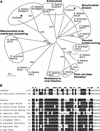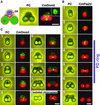A plant-specific dynamin-related protein forms a ring at the chloroplast division site
- PMID: 12615939
- PMCID: PMC150020
- DOI: 10.1105/tpc.009373
A plant-specific dynamin-related protein forms a ring at the chloroplast division site
Abstract
Chloroplasts have retained the bacterial FtsZ for division, whereas mitochondria lack FtsZ except in some lower eukaryotes. Instead, mitochondrial division involves a dynamin-related protein, suggesting that chloroplasts retained the bacterial division system, whereas a dynamin-based system replaced the bacterial system in mitochondria during evolution. In this study, we identified a novel plant-specific group of dynamins from the primitive red alga Cyanidioschyzon merolae. Synchronization of chloroplast division and immunoblot analyses showed that the protein (CmDnm2) associates with the chloroplast only during division. Immunocytochemical analyses showed that CmDnm2 appears in cytoplasmic patches just before chloroplast division and is recruited to the cytosolic side of the chloroplast division site to form a ring in the late stage of division. The ring constricts until division is complete, after which it disappears. These results show that a dynamin-related protein also participates in chloroplast division and that its behavior differs from that of FtsZ and plastid-dividing rings that form before constriction at the site of division. Combined with the results of a recent study of mitochondrial division in Cyanidioschyzon, our findings led us to hypothesize that when first established in lower eukaryotes, mitochondria and chloroplasts divided using a very similar system that included the FtsZ ring, the plastid-dividing/mitochondrion-dividing ring, and the dynamin ring.
Figures






References
-
- Allen, M.B. (1959). Studies with Cyanidium caldarium, an anomously pigmented chlorophyte. Arch. Microbiol. 32, 270–277. - PubMed
-
- Beech, P.L., Nheu, T., Schultz, T., Herbert, S., Lithgow, T., Gilson, P.R., and McFadden, G.I. (2000). Mitochondrial FtsZ in a chromophyte alga. Science 287, 1276–1279. - PubMed
-
- Bi, E., and Lutkenhaus, J. (1991). FtsZ ring structure associated with division in Escherichia coli. Nature 354, 161–164. - PubMed
Publication types
MeSH terms
Substances
Associated data
- Actions
LinkOut - more resources
Full Text Sources
Other Literature Sources
Research Materials

